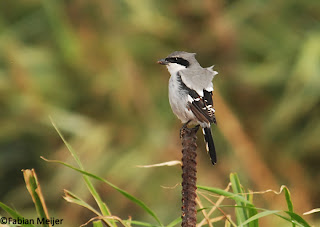My dad and I departed early this morning and headed to the plains of El Jable, west of Teguise. We had our hopes set on Houbara's, Cream-coloured Coursers, Stone Curlews and so on. We arrive at the southern part (just north of the LZ-30) around 7:15 and start to drive the dirt tracks going through the plains. Soon we see two Stone Curlews taking off in a field next to us. A bit further down the track another one appears close to the car, our first close encounter with a Stone Curlew here... and we didn't know yet what had to come! We stop the car and I do some scanning on my right with my binoculars, resulting in the find of 3 Cream-coloured Coursers. That went rather smoothly! The light is bad but I manage to get a recordshot. We were following a track to the west and have now turned right to the north. We drive on till we come upon some kind of farm, with some dirty ponds filled with goat shit, or something similar, haha. We come across many (100+) Lesser Short-toed Larks and Stone Curlews are no unusual appearance anymore with +4 seen here. They are very very cooperative and come very close, despite the very well-pronounced colour of our car: red.
One of the Cream-coloured Coursers (Cursor cursorius); poor shot
Stone Curlew (Burhinus oedicnemus insularum)
Lesser Short-toed Lark (Calandrella rufescens polatzeki); too bad that this bird just posed wrong for us..
Another Lesser Short-toed Lark
After we've had our photographic moment we continued northwards. Not much later we locate a Houbara Bustard to the right of us. The bird shows really well and we have nice views through our scope. We also locate three more Houbara Bustards north-east of there. The location is as follows: coming from Teguise you take the LZ-30 to Mozaga, on the roundabout you take the LZ-402 to Famara. Just afther the KM 2 sign a dirt track goes off the road to the left. Drive 500m and start the scan. From here we had nice views of at least three birds from a reasonable distance. The light was still very good so there were no heatwaves.
This is where we saw the three Houbara's.
Tammo watching the bustards.
The clouds that were present in the early morning had moved away, and the sun appeared instead. Near the ''farm'' we see our first Hoopoe, Cattle Egret and we discovered a territorial Southern Grey Shrike.
Southern Grey Shrike (Lanius meridionalis koenigi); the bird shows a three old outer primaries and a few old inner secondaries, all very bleached/worn. I have no experience in ageing them, I'll dig in to that sometime;)
We are back on time in the apartment and have a nice meal at noon. In the afternoon we go to Famara for a hike.
Risco de Famara
The almost two hour lasting walk brings us along the foot of the cliffs. We see our first Ravens soaring above the cliffs and Tammo gets all the credit for discovering a hunting Egyptian Vulture.
Egyptian Vulture (Neophron percnopterus majorensis); this endemic ssp has a more rufous-tinged colouration making the birds look very ''dirty''.
The family walking down at the foot of the cliffs.
Back at Costa Teguise I see a probable Alpine Swift in the evening. From the driving car is see a large swift flying together with some Plain Swifts, too bad the bird dissappears immediatly.












Geen opmerkingen:
Een reactie posten